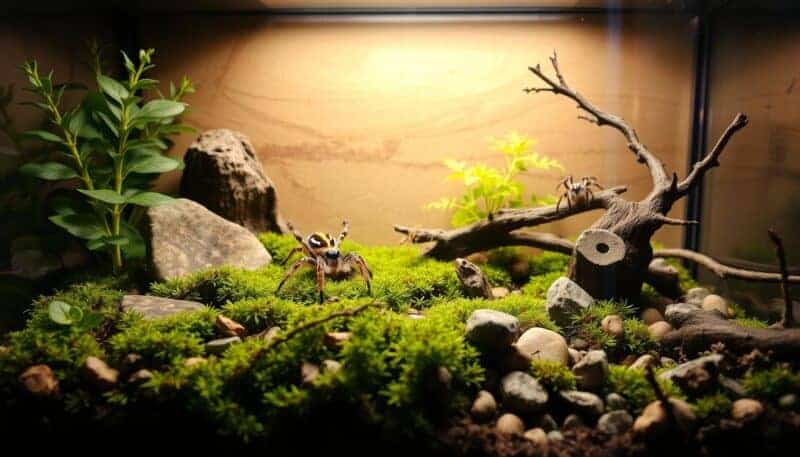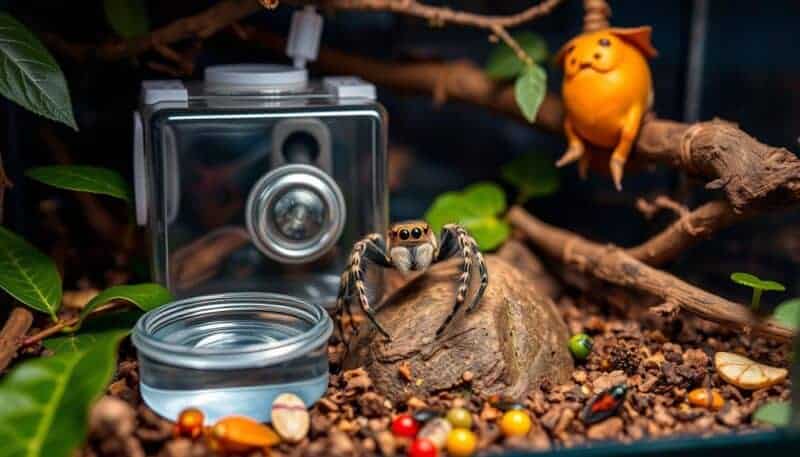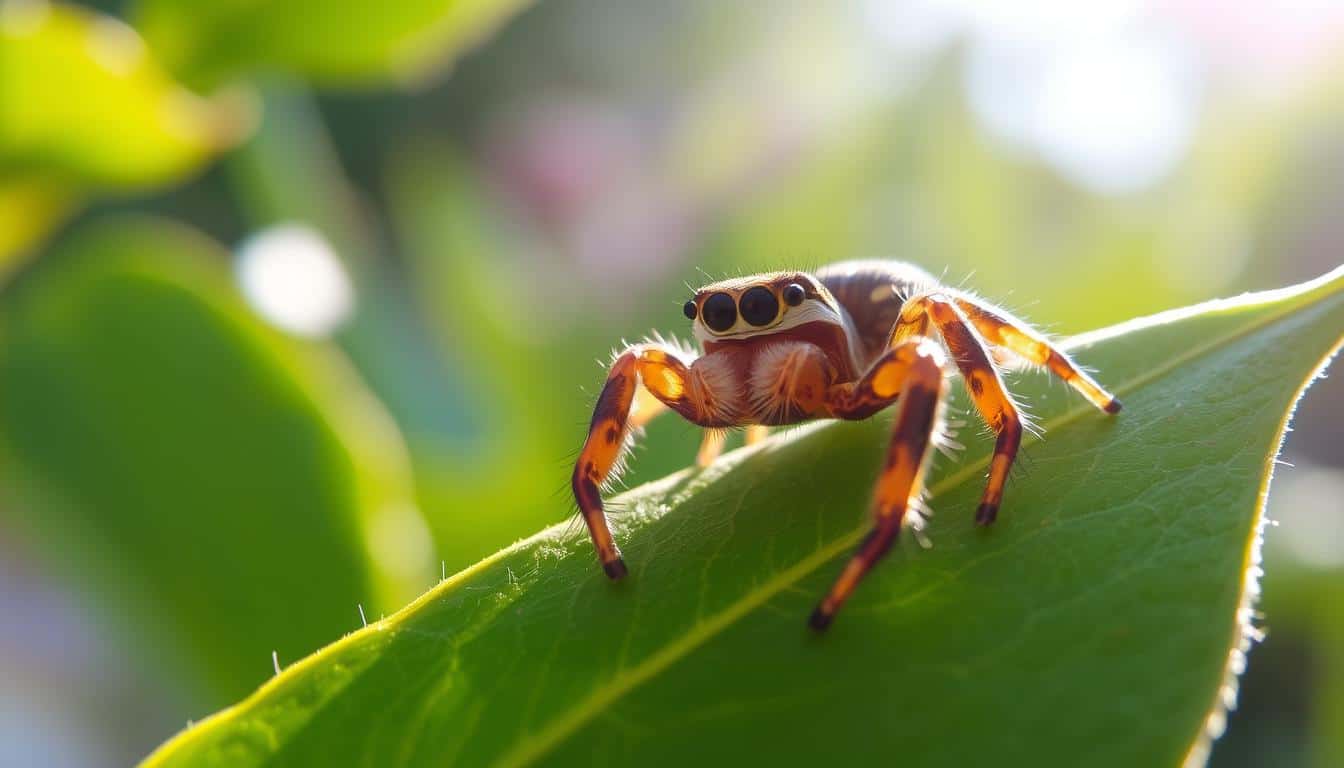Introduction
I’ve always been drawn to the world of jumping spiders. Their mesmerizing eyes and intricate movements are captivating. If you love these creatures, you might want one as a pet. But where do you start?
This guide will help you buy jumping spiders safely. We’ll cover different species and Where to Buy Jumping Spiders Safely. Whether you’re new or experienced, you’ll learn how to choose the right spider for you.
Let’s explore the world of jumping spider ownership. We’ll make sure you’re ready to start this journey with confidence and care.
- Understanding Jumping Spiders as Pets
- Reputable Online Retailers and Breeders
- Local Pet Stores and Exotic Animal Shops
- Essential Jumping Spider Care Before Purchase
- Setting Up the Perfect Habitat
- Pricing and Budget Considerations
- Legal Requirements and Restrictions
- Health Check: What to Look for When Buying
- FAQ:
Understanding Jumping Spiders as Pets
Jumping spiders are becoming more popular as pets. They have amazing vision and can jump far. This makes them fun and educational for those interested in arachnids.
Common Species for Beginners
The Bold Jumping Spider and the Regal Jumping Spider are great for beginners. They are easy to find and do well in captivity. This makes them perfect for new pet owners.
Natural Behaviors and Characteristics
Jumping spiders have incredible eyesight. Some can see in full color and spot movement from far away. They hunt by stalking and pouncing, using their quick reflexes.
They also have cool courtship displays. They use their bright colors and acrobatics to attract mates.
Life Expectancy and Development Stages
Jumping spiders live about 1 to 2 years. Most of their life is spent as adults. Their growth from egg to adult is interesting, with many molts and changes.
“Jumping spiders are fascinating creatures that offer a unique and engaging pet-keeping experience. Their remarkable behaviors and abilities make them a captivating choice for those interested in the arachnid world.”
Reputable Online Retailers and Breeders
Finding reliable online sources for jumping spiders is key. Josh’s Frogs and Bugs in Cyberspace are two top retailers. They offer a wide range of jumping spider species and are known for quality and service.
Online forums like Arachnoboards are also great for finding breeders. These communities have members who breed and sell jumping spiders. You can find unique morphs and support small breeders here.
Verifying Seller Credibility
When buying jumping spiders online, do your homework. Look for sellers with good reviews, clear communication, and fair shipping policies. Good retailers and breeders will answer your questions and share details about their animals.
- Check seller ratings and feedback from previous customers
- Ensure the seller has a professional website or online presence
- Verify that the seller is knowledgeable about jumping spider care and can provide guidance
- Confirm that the seller uses secure and reliable shipping methods
By carefully choosing a trustworthy online source, you can be sure of a great jumping spider purchase. This ensures your new pet gets the best care.
Local Pet Stores and Exotic Animal Shops
Looking for the perfect jumping spider? Local pet stores and exotic animal shops are great places to start. They let you see and touch potential pets before buying. But, it’s important to choose a store that cares for its animals well.
What to Look for in a Physical Store
When you visit a pet store or exotic animal shop, notice how clean and organized it is. A clean place is key for a healthy spider. Look for enclosures that are clean, have the right temperature and humidity, and have places for the spider to hide and play.
Questions to Ask Retailers
- Ask where the jumping spiders come from, as if They were either bred in captivity, or captured in the wild.
- Find out what the spider needs to stay healthy, making sure the store knows how to help.
- Ask about returning or exchanging a spider if it doesn’t fit in at home.
Red Flags to Watch Out For
- Watch how the spiders act and look. Stay away from any that seem sick, hurt, or act strangely.
- Be cautious if the store can’t give you clear info about the spiders, like what they need or where they come from.
- Don’t go to a store that seems more interested in making money than in taking care of animals.
Being smart and careful can help you find a healthy jumping spider from a good local store. Always put your new pet’s happiness first.
Essential Jumping Spider Care Before Purchase
Getting a new jumping spider is exciting, but you must prepare first. To make sure your spider is happy and healthy, think about a few important things before purchasing a jumping spider.
Start by learning about the care needs of the spider you want. Jumping spiders need the right jumping spider enclosure size, temperature, humidity, and food. Knowing this will help you create the best home for your spider.
Then, get all the things your spider will need before it arrives. You’ll need a good enclosure, substrate, hiding places, water, and food. Having everything ready will make it easier for both you and your spider.
- Secure a properly sized jumping spider enclosure with good air flow
- Choose a good substrate, like coconut fiber or sphagnum moss
- Add hiding spots and decorations to mimic its natural home
- Make sure there’s clean water, like a small dish
- Find a steady, healthy diet of live insects or other right prey
By preparing and learning about your spider’s needs, you’ll create a safe and happy home. This first step will help you enjoy your time with your jumping spider.

Setting Up the Perfect Habitat
Creating a cozy and stimulating home for your jumping spider is key to their happiness. When setting up their new home, consider a few important things.
Enclosure Size and Materials
The enclosure should match your spider’s size. Aim for a space that’s 3-4 times the spider’s leg span. Glass, plastic, or acrylic terrariums work well. Be sure to check for good airflow as well as a secure top to keep your spider inside.
Temperature and Humidity Requirements
Jumping spiders like it warm, between 70-80°F (21-27°C). They also prefer a humidity of 65-75%. Use heat mats or lamps to keep the temperature right. Keep an eye on the humidity and adjust it to keep your spider comfy.
Decorations and Enrichment Items
- Make sure your spiders have the opportunity to climb on branching or synthetic plants. This lets them jump and hunt like they do in the wild.
- Provide hiding places, like small caves or overturned pots. This makes your spider feel safe and gives them a place to rest.
- Add natural elements like leaves or moss. This makes their home feel more like their natural habitat.
By making a jumping spider habitat that’s both fun and safe, your spider will be happy and healthy. Always make sure to check their house and make adjustments when needed to keep it perfect for your jumping spider enclosure.
Pricing and Budget Considerations
Thinking about getting a jumping spider? It’s important to focus on the financial aspect. The price for these cool spiders can change a lot. It depends on the jumping spider species and where you buy it.
Prices usually range from $20 to $100 for a young or adult spider. Some rare ones might cost more. But, the cost of buying one is just the start. You’ll also need to think about setting up a good home for it and the ongoing care costs.
Budgeting for the Essentials
- Enclosure: $20 to $100 or more, depending on size and materials
- Substrate: $5 to $15 per bag
- Decorations and hides: $10 to $50 or more
- Food (such as crickets or fruit flies): $5 to $20 per month
- Water source and misting equipment: $10 to $30
Remember, your spider’s health and happiness should be your main goal. Spending in the right stuff will help your pet live well and long.

Knowing the costs ahead helps you plan a budget. This way, you can give your jumping spider the best care. If you are able to plan and conduct some study, you can have a great time with these amazing spiders as pets.
Legal Requirements and Restrictions
Adding a jumping spider to your family means understanding the law. Laws about owning these spiders vary by state. It’s key to check the laws in your area before buying.
State-Specific Regulations
Keeping a jumping spider as a pet can have different rules in each state. Some places might not let you have certain spiders. Others might need you to get a special permit. It’s your responsibility to understand the rules of your state.
- Learn about your state’s laws on jumping spiders.
- Determine if you require any permits or licences to Own one.
- Know any age limits or how many spiders you can have.
Import/Export Guidelines
Buying a jumping spider from another state or country has its own rules. Some spiders might need special papers to move across borders.
- Check if you can bring a jumping spider into your state.
- Learn about any papers you need for shipping spiders internationally.
- Make sure the seller follows all import and export laws.
Knowing and following the laws helps you enjoy owning a jumping spider without trouble. Doing your homework now can prevent problems later.
Health Check: What to Look for When Buying
Before buying a new jumping spider, it’s important to check its health. Look at the spider’s eyes first. They must be clear and bright, not cloudy or discolored.
Also, watch how the spider moves. A healthy spider will move quickly and respond well to things around it.
Check if the spider has molted recently. A healthy spider will molt often to grow. Look for soft body or color changes that suggest a molt.
Finally, consider quarantining new spiders. This step helps keep your other pets safe from diseases. By carefully checking and isolating new spiders, you can keep your jumping spider family healthy and happy.
FAQ:
Is it OK to keep jumping spiders?
Keeping Jumping Spiders as pets can be a fascinating experience. These agile arachnids are low-maintenance, requiring minimal space and simple habitats. With their curious personalities and vibrant colors, they captivate enthusiasts. As long as their basic needs are met—appropriate enclosures, proper humidity, and live prey—Jumping Spiders thrive in captivity and make unique companions.
What is the best place to find a jumping spider?
The best place to find Jumping Spiders is often right in your backyard. These curious creatures thrive in gardens, wooded areas, and near sunny windowsills. Look for them among plants, tree bark, or crevices where they hunt and rest. Exotic species of Jumping Spiders can also be sourced through reputable breeders.
How to get a pet jumping spider?
To get a pet Jumping Spider, explore local gardens or forests where they naturally reside, capturing them gently in a ventilated container. For exotic species, connect with reputable breeders or exotic pet shops specializing in Jumping Spiders. Ensure a proper habitat is prepared, mimicking their natural environment for a thriving companion.
Can you own a jumping spider in the UK?
In the UK, owning Jumping Spiders as pets is entirely legal and increasingly popular. These fascinating arachnids require minimal care, making them ideal for enthusiasts. You can find native species locally or purchase exotic Jumping Spiders from specialized breeders. Always ensure ethical sourcing and create a habitat that meets their unique needs.
What is the lifespan of a pet jumping spider?
The lifespan of Jumping Spiders in captivity typically ranges from one to two years, depending on the species and care. With proper feeding, temperature regulation, and a stress-free environment, these captivating arachnids can thrive. Regular monitoring ensures your pet Jumping Spiders enjoy a healthy and fulfilling life in their meticulously crafted habitat.
Why do jumping spiders wave at you?
Jumping Spiders wave as a form of communication, using their front legs to signal curiosity or establish territory. This behavior, known as “leg-waving,” often occurs when they perceive movement. Highly visual creatures, Jumping Spiders rely on these intricate gestures to interact with their environment, showcasing their fascinating social instincts.
Share your thoughts in the comments below! If you enjoyed this post, consider subscribing to our newsletter for more pet tips, stories and blogs!

